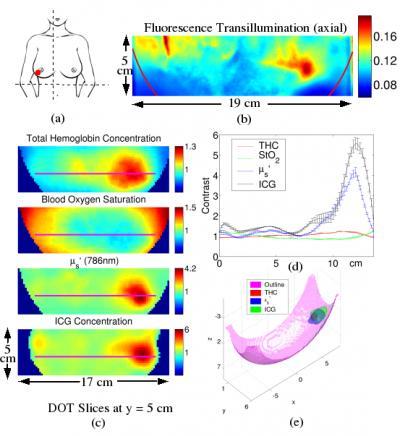Researchers at the University of Pennsylvania have created the first three-dimensional optical images of human breast cancer in patients based on tissue fluorescence.
Fluorescence diffuse optical tomography, or FDOT, relies on the presence of fluorophore molecules in tissue that re-radiate fluorescent light after illumination by excitation light of a different color.
The reconstructed images demonstrated significant tumor contrast compared to typical endogenous optical contrast in breast. Tumor-to-normal tissue contrast based on FDOT with the fluorophore Indocyanine Green, or ICG, was two-to-four-fold higher than contrast based on endogenous contrasts such as hemoglobin and scattering parameters obtained with traditional diffuse optical tomography, or DOT. a) Illustration the location of the tumor from a patient diagnosed with invasive ductal carcinoma. b) A localized fluorescence uptake is observed from the transillumination image at the lateral side where the tumor is expected to be found. Note that our CCD camera view is caudal-cranial (from foot to head), so the right and left side correspond to lateral and medial sides, respectively, for the right breast. c) Image slices from 3-D tomographic reconstructions display the contrasts of the following physiological parameters: Total hemoglogin concentration (THC), oxygen saturation (StO2), reduced scattering and fluorophore (ICG) concentration. d) From the the profile plot (along the pink line in (c)), we observe that scattering and ICG concentration exhibit up to four- and 5.5-fold contrast, respectively, whereas THC contrast is only 1.3 and and StO2 does not show any significant contrast. The large tumor contrast obtained with a non-targeted exogenous fluorophore (ICG) portends a promising future as molecularly targeted dyes and beacons become available for clinical use. e) 3-D iso-surface images of THC, scattering and ICG concentration contrast. The iso-surfaces of the three contrasts overlay one another quite well. Credit: Alper Corlu
a) Illustration the location of the tumor from a patient diagnosed with invasive ductal carcinoma. b) A localized fluorescence uptake is observed from the transillumination image at the lateral side where the tumor is expected to be found. Note that our CCD camera view is caudal-cranial (from foot to head), so the right and left side correspond to lateral and medial sides, respectively, for the right breast. c) Image slices from 3-D tomographic reconstructions display the contrasts of the following physiological parameters: Total hemoglogin concentration (THC), oxygen saturation (StO2), reduced scattering and fluorophore (ICG) concentration. d) From the the profile plot (along the pink line in (c)), we observe that scattering and ICG concentration exhibit up to four- and 5.5-fold contrast, respectively, whereas THC contrast is only 1.3 and and StO2 does not show any significant contrast. The large tumor contrast obtained with a non-targeted exogenous fluorophore (ICG) portends a promising future as molecularly targeted dyes and beacons become available for clinical use. e) 3-D iso-surface images of THC, scattering and ICG concentration contrast. The iso-surfaces of the three contrasts overlay one another quite well. Credit: Alper Corlu
With the continued development of molecularly-targeted exogenous fluorophores, the research helps pave the way for diagnostic tools based on optics that will provide improved sensitivity and specificity between healthy and normal tissues.
Fluorophores are exquisitely sensitive to their local environment, and therefore FDOT holds potential to provide information about tumor physiology, including tissue oxygen, tissue pH and tissue calcium concentration levels.
“Previously, the FDOT technique was used for in-vivo imaging of animal tissues, but ours is the first successful demonstration of its use to detect cancer in deep-tissue, human breast imaging,” Arjun Yodh, professor of physics at Penn, said.
DOT uses near-infrared light to scan and provide cross-sectional and volumetric views of biological tissue. It is promising as a tool to characterize lesions and monitor therapy; however, its resolution is not as high as other anatomically oriented imaging modalities, and contrast comes mainly from vasculature abnormalities.
In the current study using FDOT, the intravenous addition of an exogenous molecular agent, ICG, was used to enhance tumor contrast. The vasculature of tumors delays ICG washout from the body and thereby elevates its concentration in tumors relative to normal tissue. Penn researchers plan to improve the instrument in order to assess the flourophore lifetime which will provide richer information about tumor physiology.
“The potential uses of optical fluorophores bear close resemblance to the use of contrast agents in PET and MRI,” Yodh said. “Successful FDOT represents a critical first step towards application of molecular imaging probes such as dyes and molecular beacons that bind to tumor-specific receptors in deep tissue, a current direction for biomedical optics research.”
Penn researchers accomplished fluorescence excitation and detection in the soft-compression, parallel-plane, transmission geometry using laser sources at 786 nm and spectrally filtered CCD detection.
The study was conducted by Alper Corlu, Regine Choe, Turgut Durduran and Yodh from Penn’s Department of Physics and Astronomy in the School of Arts and Sciences; Mitch Schnall and Mark Rosen from the Radiology Department of the University of Pennsylvania Health System, and colleagues from University College London. The research was supported by the National Institutes of Health and the Network for Translational Research in Optical Imaging.
Source: University of Pennsylvania